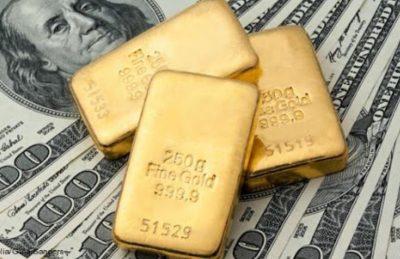Gold: between fear of the dollar and speculation
Historically, gold is a measure and reserve of value. In times of crisis, it also becomes a refuge and object of speculation.
- Opinión

Record gold prices from 2019 onwards express the international monetary system's vulnerability resulting from the US-China trade war and, recently, the impact of COVID-19 on the global economy. Historically, gold is a measure and reserve of value. In times of crisis, it also becomes a refuge and object of speculation. If the price of gold links movements in the international financial markets to the US central bank's expansive monetary policy, does the current price of gold express speculation? Are there expectations of crises arising from the pandemic shock, the economic collapse, the trade war, the new cold war, or were they already present?
At the beginning of the 20th century, the pound sterling was the international reference currency (top currency) anchored to gold. The First World War undermined the international gold-based monetary system and forced the use of pounds and dollars, backed by gold. In 1925, Winston Churchill fixed the gold/pound parity and abandoned it in 1931; soon, in 1935, the dollar became an international master currency. The UK and the US agreed to the gold dollar parity at US$35 oz and established exchange rate stabilization funds in 1935.
Bretton Woods ratified this convertibility until July 1968 (see graph) when American deficits and pressure from France led to the devaluation of the dollar to US$ 43.50 oz. Three years later, President Nixon ended gold convertibility and freed the exchange market at Friedman's suggestion.
The price of the metal has tended to rise, with ups and downs, like other commodities. Between August 1971 and December 1979, it rose from US$44 oz. to $524 oz., as a reflection of the weakness of the currency. In the late 1980s, after the debt crisis of the emerging economies, it returned to US$401 oz. The relief that none of the countries had triggered an economic conflagration over the debt pacified the gold market. At the end of the 20th century, amid globalization, with US deficits initially reduced, and the end of the Cold War, gold dropped even further to US$290 oz.
In the first decade of the 21st century, following the Atlantic financial crisis in September 2008, gold rose to a record of $1,220 oz in early December. Between August 2007, when it became a refuge of value and a source of physical speculation, and 2012, when the Senate Banking Committee ruled that there were three banks: the Bank of Nova Scotia, Deutsche Bank, and HSBC, speculating with physical gold, the price collapsed from US$1,767 oz in October 2012. When the banks divested their physical gold positions, the price fell to a low of US $1,050 oz. in December 2015.
The end of the US FED quantitative easing from 2014 allowed prices to recover to the range of US$ 1,300 oz., where they remained until 2019. As the FED in April 2019 reduced the Fed Funds Rate from 2.42% to 1.10% in July 2020, gold recovered. The psychological barrier of US$ 2,000 oz. broke on March 23, 2020, induced by the beginning of the new sizeable quantitative expansion of the FED, in order to provide liquidity to the banking and non-banking financial sector. The institutional reaction was to buy financial assets, including gold, which on August 6, 2020, reached the record of US$ 2089.2 oz. while stock markets hit their highest peak. The price of gold is a symptom of poor economic and financial conditions and the degree of economic uncertainty. Consequently, when large funds receive money from the FED, they enter the gold market. That is why there was an accelerated increase in the gold price with the recent expansion of the Fed's balance sheet (unsecured liquidity), which is already close to 40% of the US GDP.
According to the World Gold Council, in recent years, no increase in production costs has been observed, and the demand for gold has been reduced, except for Exchange Traded Funds (ETF), where there is an increase of 438% per year.
These have accumulated globally 3,812 tons of gold (as of August 7, 2020). Gold Share Fund (GLD), managed by State Street Bank, is backed by 1,261 tons of gold and one of the world's largest gold owners. The amount exceeds the reserves of the central banks of Japan, India, or England. Another highlight is the BlackRock investment fund. Both add up to more than half of the world's gold reserves of ETF's and represent one-fifth of global demand for the metal to date.
Finally, the current gold price expresses the refuge value in the face of uncertainty, channelled by investors through two large funds. The crisis expectations were already in 2019 when the price began to rise as a reflection of the trade war and the fall in American GDP growth. It became accentuated by the economic disaster of 2020. The price of gold may accompany all of the following credit expansions by the Fed.
- Oscar Ugarteche, Senior Researcher "C", Instituto de Investigaciones Económicas, UNAM, Conacyt-SNI III, obela.org coordinator
- Bertin Acosta Bautista, Faculty of Economics, UNAM, member of the obela.org
Source: Observatorio Económico Latinoamericano - OBELA, www.obela.org
Del mismo autor
- El multilateralismo bipolar 08/03/2022
- Bipolar multilateralism 07/03/2022
- What does 2022 bring? Uncertainty 31/01/2022
- ¿Qué trae el 2022? Incertidumbre 31/01/2022
- The most expensive Christmas of the century... (so far) 20/01/2022
- La navidad más cara del siglo (hasta ahora) 20/01/2022
- Lo que pasó en el 2021 10/01/2022
- What happened in 2021 10/01/2022
- Estados Unidos: el elefante en la habitación 08/11/2021
- The elephant in the room 07/11/2021
Clasificado en
Clasificado en:
Crisis Económica
- Geraldina Colotti 07/04/2022
- Julio C. Gambina 07/04/2022
- Rafael Bautista S. 06/04/2022
- Julio Gambina 04/04/2022
- José Ramón Cabañas Rodríguez 01/04/2022








